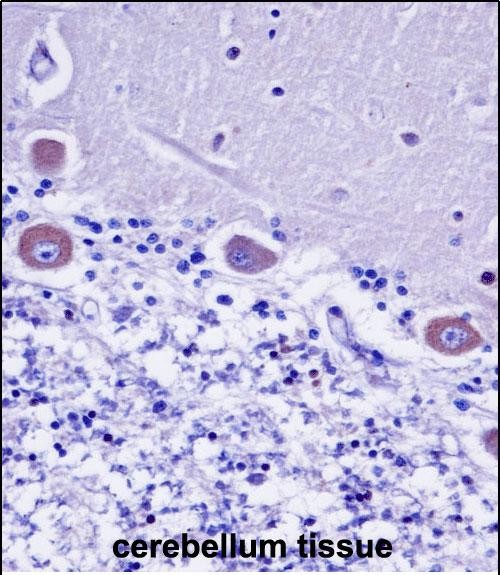KDELR2 Antibody (C-term)
Affinity Purified Rabbit Polyclonal Antibody (Pab)
- SPECIFICATION
- CITATIONS
- PROTOCOLS
- BACKGROUND

Application
| IHC-P, WB, E |
|---|---|
| Primary Accession | P33947 |
| Other Accession | Q5U305, Q9CQM2, Q2KJ37, Q569A6, Q99JH8, P24390, P33946, Q68ES4, NP_006845.1, NP_001094073.1 |
| Reactivity | Human |
| Predicted | Xenopus, Bovine, Mouse, Rat |
| Host | Rabbit |
| Clonality | Polyclonal |
| Isotype | Rabbit IgG |
| Calculated MW | 24422 Da |
| Antigen Region | 183-211 aa |
| Gene ID | 11014 |
|---|---|
| Other Names | ER lumen protein-retaining receptor 2, ERD2-like protein 1, ELP-1, KDEL endoplasmic reticulum protein retention receptor 2, KDEL receptor 2, KDELR2, ERD22 |
| Target/Specificity | This KDELR2 antibody is generated from rabbits immunized with a KLH conjugated synthetic peptide between 183-211 amino acids from the C-terminal region of human KDELR2. |
| Dilution | WB~~1:1000 IHC-P~~1:10~50 |
| Format | Purified polyclonal antibody supplied in PBS with 0.09% (W/V) sodium azide. This antibody is purified through a protein A column, followed by peptide affinity purification. |
| Storage | Maintain refrigerated at 2-8°C for up to 2 weeks. For long term storage store at -20°C in small aliquots to prevent freeze-thaw cycles. |
| Precautions | KDELR2 Antibody (C-term) is for research use only and not for use in diagnostic or therapeutic procedures. |
| Name | KDELR2 |
|---|---|
| Synonyms | ERD2.2 {ECO:0000303|PubMed:1325562} |
| Function | Membrane receptor that binds the K-D-E-L sequence motif in the C-terminal part of endoplasmic reticulum resident proteins and maintains their localization in that compartment by participating to their vesicle-mediated recycling back from the Golgi (PubMed:1325562, PubMed:18086916, PubMed:33053334). Binding is pH dependent, and is optimal at pH 5-5.4 (By similarity). |
| Cellular Location | Endoplasmic reticulum membrane; Multi-pass membrane protein {ECO:0000250|UniProtKB:Q5ZKX9}. Golgi apparatus membrane; Multi-pass membrane protein {ECO:0000250|UniProtKB:Q5ZKX9}. Cytoplasmic vesicle, COPI-coated vesicle membrane; Multi-pass membrane protein {ECO:0000250|UniProtKB:Q5ZKX9} Note=Localized in the Golgi in the absence of bound proteins with the sequence motif K-D-E-L. Trafficks back to the endoplasmic reticulum together with cargo proteins containing the sequence motif K-D-E-L |

Thousands of laboratories across the world have published research that depended on the performance of antibodies from Abcepta to advance their research. Check out links to articles that cite our products in major peer-reviewed journals, organized by research category.
info@abcepta.com, and receive a free "I Love Antibodies" mug.
Provided below are standard protocols that you may find useful for product applications.
Background
Retention of resident soluble proteins in the lumen of the endoplasmic reticulum (ER) is achieved in both yeast and animal cells by their continual retrieval from the cis-Golgi, or a pre-Golgi compartment. Sorting of these proteins is dependent on a C-terminal tetrapeptide signal, usually lys-asp-glu-leu (KDEL) in animal cells, and his-asp-glu-leu (HDEL) in S. cerevisiae. This process is mediated by a receptor that recognizes, and binds the tetrapeptide-containing protein, and returns it to the ER. In yeast, the sorting receptor encoded by a single gene, ERD2, is a seven-transmembrane protein. Unlike yeast, several human homologs of the ERD2 gene, constituting the KDEL receptor gene family, have been described. KDELR2 was the second member of the family to be identified, and it encodes a protein which is 83% identical to the KDELR1 gene product. Alternative splicing results in multiple transcript variants encoding distinct isoforms. [provided by RefSeq].
References
van der Vlies, D., et al. Biochem. J. 366 (PT 3), 825-830 (2002) :
Pelham, H.R. Cell Struct. Funct. 21(5):413-419(1996)
Lewis, M.J., et al. J. Mol. Biol. 226(4):913-916(1992)
Hsu, V.W., et al. Cell 69(4):625-635(1992)
If you have used an Abcepta product and would like to share how it has performed, please click on the "Submit Review" button and provide the requested information. Our staff will examine and post your review and contact you if needed.
If you have any additional inquiries please email technical services at tech@abcepta.com.













 Foundational characteristics of cancer include proliferation, angiogenesis, migration, evasion of apoptosis, and cellular immortality. Find key markers for these cellular processes and antibodies to detect them.
Foundational characteristics of cancer include proliferation, angiogenesis, migration, evasion of apoptosis, and cellular immortality. Find key markers for these cellular processes and antibodies to detect them. The SUMOplot™ Analysis Program predicts and scores sumoylation sites in your protein. SUMOylation is a post-translational modification involved in various cellular processes, such as nuclear-cytosolic transport, transcriptional regulation, apoptosis, protein stability, response to stress, and progression through the cell cycle.
The SUMOplot™ Analysis Program predicts and scores sumoylation sites in your protein. SUMOylation is a post-translational modification involved in various cellular processes, such as nuclear-cytosolic transport, transcriptional regulation, apoptosis, protein stability, response to stress, and progression through the cell cycle. The Autophagy Receptor Motif Plotter predicts and scores autophagy receptor binding sites in your protein. Identifying proteins connected to this pathway is critical to understanding the role of autophagy in physiological as well as pathological processes such as development, differentiation, neurodegenerative diseases, stress, infection, and cancer.
The Autophagy Receptor Motif Plotter predicts and scores autophagy receptor binding sites in your protein. Identifying proteins connected to this pathway is critical to understanding the role of autophagy in physiological as well as pathological processes such as development, differentiation, neurodegenerative diseases, stress, infection, and cancer.



